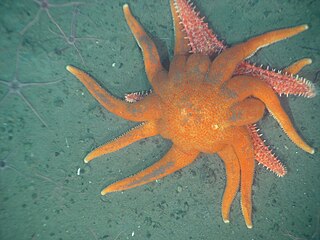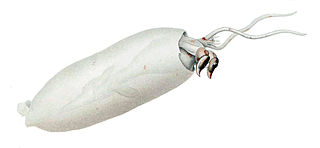Related Research Articles

The Clionidae are a family of sea angels, which are a group of pelagic marine gastropods.
Spirolina is a genus of foraminifera in the family Peneroplidae.

Tube-dwelling anemones or ceriantharians look very similar to sea anemones but belong to an entirely different subclass of anthozoans. They are solitary, living buried in soft sediments. Tube anemones live inside and can withdraw into tubes, which are composed of a fibrous material made from secreted mucus and threads of nematocyst-like organelles known as ptychocysts. Within the tubes of these ceriantharians, more than one polyp is present, which is an exceptional trait because species that create tube systems usually contain only one polyp per tube. Ceriantharians were formerly classified in the taxon Ceriantipatharia along with the black corals but have since been moved to their own subclass, Ceriantharia.

The Valvatida are an order of starfish in the class Asteroidea, which contains 695 species in 172 genera in 17 families.

Zoanthids are an order of cnidarians commonly found in coral reefs, the deep sea and many other marine environments around the world. These animals come in a variety of different colonizing formations and in numerous colors. They can be found as individual polyps, attached by a fleshy stolon or a mat that can be created from small pieces of sediment, sand and rock. The term "zoanthid" refers to all animals within this order Zoantharia, and should not be confused with "Zoanthus", which is one genus within Zoantharia.

Taoniinae is a subfamily containing ten genera of glass squids.

Heterodonta is a taxonomic subclass of saltwater clams, marine bivalve molluscs. This subclass includes the edible clams, the cockles and the Venus clams.

The Trochidae, common name top-snails or top-shells, are a taxonomic family of very small to large sea snails, marine gastropod molluscs in the clade Vetigastropoda.

Corallimorpharia is an order of marine cnidarians closely related to stony or reef building corals (Scleractinia). They occur in both temperate and tropical climates, although they are mostly tropical. Temperate forms tend to be very robust, with wide and long columns, whereas tropical forms tend to have very short columns with a wide oral disc and very short tentacles. The tentacles are usually arranged in rows radiating from the mouth. Many species occur together in large groups, although there are recorded instances of individuals. In many respects, they resemble the stony corals, except for the absence of a stony skeleton. Morphological and molecular evidence suggests that they are very closely related to stony corals.
The World Register of Marine Species (WoRMS) is a taxonomic database that aims to provide an authoritative and comprehensive list of names of marine organisms.

Preactiniidae is a family of sea anemones in the order Actiniaria The family contains two species in two monotypic genera.
The Trebouxiales are an order of green algae in the class Trebouxiophyceae. It is often found in Estonia.

Cycloseris is a genus of solitary disc corals in the family Fungiidae. They are found in the Indo-Pacific. They inhabit the lower reef slopes, and the areas between reefs with soft sediments. They tolerate turbid waters.
Turbo magnificus, common name the magnificent turban, is a species of sea snail, a marine gastropod mollusk in the family Turbinidae, the turban snails.

Phataria is a genus of sea stars in the family Ophidiasteridae from warmer parts of the East Pacific. P. unifascialis is relatively well-known and ranges from Baja California to northwest Peru, including offshore islands such as the Galápagos. The Ecuadorian P. mionactis is not well-known.
Cecidochloris is a green algae genus in the family Chlorangiellaceae.
Chronogaster elegans is a species of nematodes. It is found in fresh water in the USA.
Crassatelloidea is a superfamily of bivalves in the order Carditida. In the World Register of Marine Species (WoRMS), Astartoidea is considered a junior synonym of Crassatelloidea, whereas in ITIS Astartoidea is a separate family containing Astartidae and Cardiniidae – Cardiniidae itself being classified instead in Carditoidea by WoRMS.
Thaumatocyprididae is a family of ostracods in the order Halocyprida which contains seven genera and one subfamily. It appeared in the Lopingian Epoch, 259.9 million years ago.